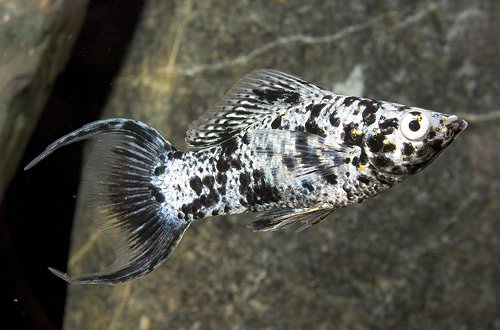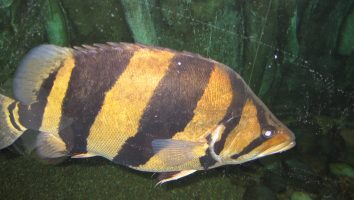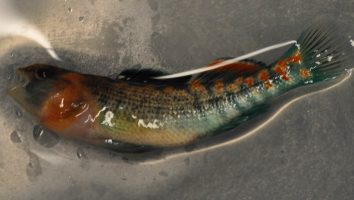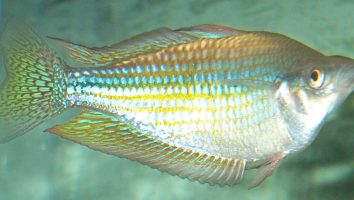The Lyretail Molly is a beautiful fish that is popular in the aquarium trade. They are easy to care for and make a great addition to any freshwater tank.
Lyretail Mollies are peaceful fish that get along well with other community fish. They are not aggressive and will not bother other fish in the tank.
This guide will teach you everything you need to know about Lyretail Molly care. You’ll learn about their diet, size, lifespan, and more!
Table of contents
Species overview
Lyretail Molly (Poecilia mexicana) is a type of freshwater fish that is commonly found in Mexico and the southern parts of the United States.
They prefer areas with a lot of vegetation and slow-moving water. This is something to keep in mind when setting up their aquarium as they will need plenty of places to hide and feel safe.
Lyretail Molly are omnivores and will eat a wide variety of food. In the wild, they primarily eat algae, but they will also consume small invertebrates.
This fish is a popular choice for many aquarium hobbyists due to its beautiful tail and overall peaceful nature.
Appearance

The Lyretail Molly is a beautiful fish that is easily recognizable thanks to its long, flowing fins. The fins on this fish are truly stunning and make up a good portion of its overall appearance.
The caudal fin is forked and extends well beyond the rest of the fins on the fish. The dorsal fin is also quite long and has a beautiful flowing shape to it. The anal fin is a bit shorter, but still extends well back on the fish.
All of the fins on the Lyretail Molly have a beautiful filigree look to them with lots of intricate detail. The fins are also quite colorful, with males usually being more brightly colored than females.
The body of the Lyretail Molly is long and thin, with a torpedo-like shape. This fish is a beautiful silver color with a slight greenish tint. There are also black lines that run along the body, starting at the gill plate and running back to the base of the tail.
Lifespan
The lifespan of a Lyretail Molly is around 3 to 5 years. However, it is not uncommon for them to live up to 8 years if they are well cared for.
As with all fish, there are a number of things that will impact their lifespan. Poor water quality, stress, and a suboptimal diet are all things that can shorten their life expectancy.
Size
Lyretail Molly fish can reach up to 4 inches in length, with the females usually being larger than the males.
Tank
Tank Size
The recommended tank size for a Lyretail Molly is 20 gallons. If you’re planning on keeping more than one Lyretail Molly, you should add an additional 5 to 10 gallons for each additional fish.
These fish are relatively active and do best in a tank that’s at least 20 gallons. They also do best in a tank that has plenty of hiding places and some live plants.
Water Parameters
The Lyretail Molly is a tropical fish that needs warm water to thrive. They’re also pretty sensitive to sudden changes in water parameters.
This means you need to take extra care when it comes to maintaining stable water conditions. Test the water frequently and do partial water changes as needed to keep ammonia and nitrite levels at 0 ppm.
- Water Temperature: 72°F to 82°F
- pH Levels: 7.5 to 8.5
- Water Hardness: 10 to 30 dGH
- Alkalinity Levels: 4 to 12 dKH
What To Put In Their Tank
Lyretail Molly fish are a little more finicky when it comes to the plants in their tank. They’re known to nibble on soft-leaved plants (like Java Fern), so you might want to avoid those if you can.
We recommend going with some of the more robust plants like Hornwort or Water Wisteria. These are both fast-growing plants that can handle a little bit of abuse.
As for the substrate, these fish don’t have any specific requirements. You can use gravel, sand, or even go with a bare-bottom tank if you want.
The most important thing is to avoid anything that’s too sharp or abrasive. These fish are known to be a little clumsy, so they might rub against the substrate a bit.
Something else you might want to consider adding to their tank is some driftwood. This provides them with a place to hide and makes the inside of the tank a little more interesting. It’s not a requirement, but it’s definitely something to consider.
Common Diseases
The Lyretail Molly is a hardy fish that can withstand a wide range of water conditions. However, they are still susceptible to certain diseases and illnesses.
The most common disease that affects this fish is velvet. Velvet is a parasite that is most commonly found in tanks with poor water quality.
It will present itself as a gold or yellow dust on the body of your fish. If you notice this, it’s important to take action immediately.
The good news is that velvet is relatively easy to treat. You can use a wide range of commercial treatments (just follow the instructions on the bottle).
The other disease you need to be aware of is fin rot. This is an infection that will cause the fins of your fish to rot and fall off.
It’s most commonly caused by poor water quality, but it can also be the result of an injury.
If you notice that the fins of your fish are beginning to rot, it’s important to take action immediately. Use a commercial treatment or consult your vet for the best course of action.
Behavior & Temperament
The Lyretail Molly is a peaceful fish that does well in a community tank. These fish are social creatures that enjoy being around others, but they can also be a bit nippy.
While they are peaceful with other fish, they may nip at the fins of their tank mates. This is more common when they are kept with slower-moving fish or fish with long fins.
The Lyretail Molly is an active swimmer and may chase other fish around the tank. They are also known to jump out of the water, so it’s important to have a lid on your tank.
Overall, the Lyretail Molly is a fun fish to watch. They are beautiful and add a lot of movement to the tank.
Tank Mates
Lyretail mollies are peaceful fish that do well in community tanks. They’re not overly active and prefer to stick to their own business.
This leaves plenty of room for other fish to occupy the middle and top levels of the water column.
Because they’re from brackish waters, it’s important to find tank mates that can tolerate slightly salty conditions.
Here are a few examples of compatible fish:
- Guppies
- Platies
- Swordtails
- Neon Tetras
- Silver Tip Tetras
- Black Neon Tetras
- Glowlight Tetras
- Cardinal Tetras
Breeding
Lyretail mollies are livebearers, meaning they give birth to fully-formed fry rather than laying eggs. This makes them pretty easy to breed, although there are still a few things you need to do to set up their breeding tank.
First, you need to sex your fish. This can be tricky since males and females look pretty similar. The best way to tell them apart is by looking at their fins. Males have longer and more pointy fins, while females have shorter and rounder fins.
Once you’ve sexed your fish, you need to set up a breeding tank. It should be at least 20 gallons and contain plenty of hiding places. You can use live plants, rocks, and driftwood to create hiding places.
The water should be pretty warm, around 78-80 degrees Fahrenheit. You also need to make sure the water is soft and slightly acidic, with a pH of around 6.5-7.0.
Once the tank is set up, add the female molly. She will likely be gravid (carrying fry), so it’s best to add her first. After she’s in the tank, add the male.
The male will chase the female and try to mate with her. This might go on for awhile, but eventually she will give birth to anywhere from 10-100 fry.
The fry are pretty small, so you need to be careful when you’re feeding them. They can’t eat regular fish food, so you need to either feed them baby brine shrimp or crushed-up flake food.
You also need to do regular water changes to keep the fry healthy. Once they’re big enough, you can move them to a bigger tank.
Conclusion
The Lyretail Molly is a beautiful fish that is a great addition to any freshwater aquarium. They are easy to care for and get along well with other community fish.
The only downside to owning a Lyretail Molly is that they are known to be fin nippers. So, if you have fish with long fins, you may want to reconsider adding a Lyretail Molly to your tank.
Other than that, we think they’re a great fish and would recommend them to anyone looking to add a little bit of color to their aquarium!












